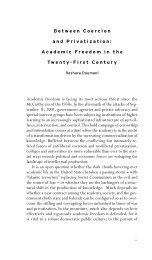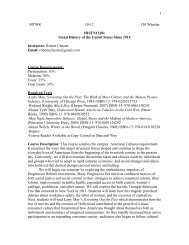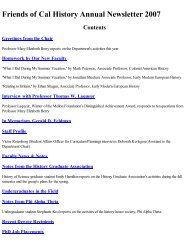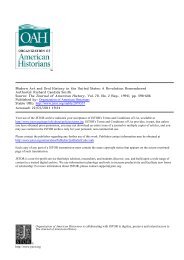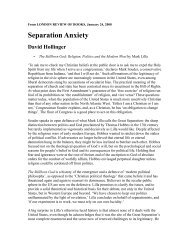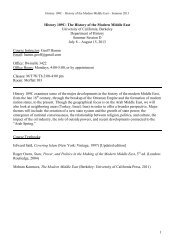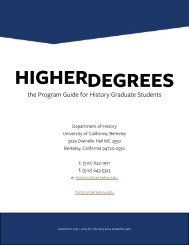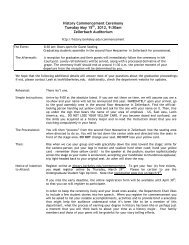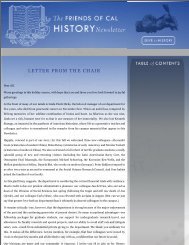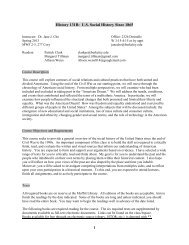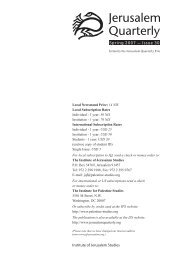David A. Hollinger | Amalgamation and Hypodescent: The Question ...
David A. Hollinger | Amalgamation and Hypodescent: The Question ...
David A. Hollinger | Amalgamation and Hypodescent: The Question ...
You also want an ePaper? Increase the reach of your titles
YUMPU automatically turns print PDFs into web optimized ePapers that Google loves.
history of denoting a permanent, physically embedded, "natural kind" is asked now to refer to contingent social relationships thatmany advocates of the word's continued use believe can <strong>and</strong> should be changed. In this context, some discussants (for example,Blum, "I'm Not a Racist," esp. 147–63) now refer to "racialized groups" instead of "races."55 Ê Farley, "Racial Issues," 126; Suro, "Mixed Doubles," 58.56 Ê Eva Saks, "Representing Miscegenation Law," Raritan 8 (Fall 1988): 39–69.57 Ê John D. Skrenty, <strong>The</strong> Minority Rights Revolution (New York, 2002). See also the essays collected in Skrentny, ed., Color Lines:Affirmative Action, Immigration, <strong>and</strong> Civil Rights Options for America (Chicago, 2001).58 Ê <strong>The</strong> somewhat different perspective advanced by leaders of African-American organizations in different periods is illustrated bythe praise black leaders of the late 1940s gave to Sinclair Lewis's Kingsblood Royal, a novel that was in fact based on the life of thelight-skinned Walter White, president of the National Association for the Advancement of Colored People. Although the novel'sdevastating critique of anti-black racism <strong>and</strong> the illogic of the one-drop rule found little white support, Lewis's implication thatblackness was a social construct was welcomed by many black Americans, as readers of the New York Times were recently remindedby Brent Staples, "When the Bard of 'Main Street' Turned the Kingsbood Family Black," New York Times (August 18, 2002): IV, 12.For a sound analysis of the novel <strong>and</strong> the difficulties white critics of the 1940s had in underst<strong>and</strong>ing it, see Jacobson, Whiteness of aDifferent Color, 265–71. Lewis in effect drew Norman Rockwell's family tree with a black face in it.59 Ê Michael Novak, <strong>The</strong> Rise of the Unmeltable Ethnics (New York, 1971).60 Ê <strong>The</strong> most influential intervention to this effect was Herbert Gans, "Symbolic Ethnicity," Ethnic <strong>and</strong> Racial Studies 2 (1979): 1–20.61 Ê It should be noted that the unique historical <strong>and</strong> constitutional situation of American Indians was widely recognized by Congress<strong>and</strong> the federal courts during this period, even while American Indians were commonly incorporated into the educational <strong>and</strong>entitlement programs described here. <strong>The</strong> passage in 1978 of the Indian Child Welfare Act is an example of Indian-specificmeasures developed during the 1970s.62 Ê Hugh Davis Graham, Collision Course: <strong>The</strong> Strange Convergence of Affirmative Action <strong>and</strong> Immigration Policy in America(New York, 2002); John D. Skrentny, "Affirmative Action <strong>and</strong> New Demographic Realities," Chronicle of Higher Education(February 16, 2001).63 Ê One Republican senator attempting to discredit all of Affirmative Action observed that the wealthiest monarch in the world, theBorneo-based sultan of Brunei, would be in principle eligible for Affirmative Action if he immigrated to the United States. For thisincident, <strong>and</strong> for an analysis of the decision of most Republicans to live with Affirmative Action despite its lack of popularity withvoters, see John D. Skrentny, "Republican Efforts to End Affirmative Action: Walking a Fine Line," in Martin A. Levin, et al.,Seeking the Center: Politics <strong>and</strong> Policymaking at the New Century (Washington, D.C., 2001), 132–71. For examples of presscoverage of European immigrants (especially from Portugal) who obtained contracts under Affirmative Action programs, seeGraham, Collision Course, 154–55.64 Ê Just how far the need to clarify the basis for entitlements for non-blacks was from almost everyone's mind is indicated by thecharacter of the discussion that took place in 1965 at the single hearing held by the Equal Employment Opportunity Commission onEEO–1, the precedent-setting employer reporting form that became the model for later Affirmative Action documents throughoutfederal <strong>and</strong> state officialdoms <strong>and</strong> in the private sector. Although this form was defined by the four classic "minorities" of theethnoracial pentagon that were made general to the entire federal bureaucracy in 1977 through the legendary Statistical DirectiveNo. 15 of the Office of Management <strong>and</strong> Budget, no voice at the hearing commented even in passing on the non-black minorities.Everyone assumed the non-black groups to be so tiny a part of the picture as to require no discussion <strong>and</strong> to entail no policydilemmas in the future. I owe this information about the EEOC hearing to John D. Skrentny.65 Ê A prominent example of a vigorous mid-1990s defense of Affirmative Action that avoids the issue of immigrant eligibility isStephen Steinberg, Turning Back: <strong>The</strong> Retreat from Racial Justice in American Thought <strong>and</strong> Policy (Boston, 1995). Steinberg dealsextensively with immigration, which he sees as largely damaging to African Americans. But he treats Affirmative Action itself as ifit applied only to African Americans, <strong>and</strong> thus his arguments for its perpetuation, which are grounded in an analysis of the history ofthat single group, do not speak directly to the specific programs that were being diminished <strong>and</strong> abolished.



